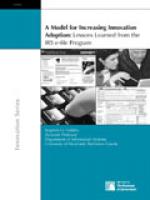
A Model for Increasing Innovation Adoption: Lessons Learned from the IRS e-file Program

In less than a decade, the number of taxpayers filing their tax returns electronically has gone from 20 percent in 1998 to 57 percent in 2006. In evaluating the IRS e-file program, Dr. Holden uses an "innovation adoption model" to describe what the IRS did to increase taxpayers’ use of the e-file system. Holden provides new and valuable insights into key factors involved in the successful adoption of e-services. He identifies the critical challenges and key steps that agencies can take in assessing their approach to adopting innovative ways of delivering services.
In addition to an organization’s technical strategy for implementing innovation, Dr. Holden highlights the importance of external relationships with stakeholders, distributors, and taxpayers as well as internal management, policy, and organizational structure issues. Effectively managing both external and internal dynamics were key to e-file realizing its long-awaited potential.E-Government, IRS, E-file Program, Innovation, Innovation Adoption Model, Electronic Filing, Technology Adoption, Innovation Diffusion, Tax Filing Innovation



